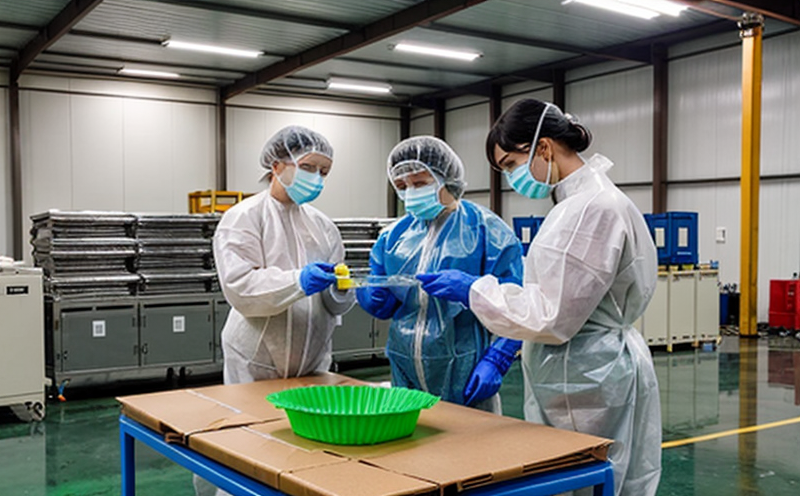Plastic Packaging Testing
Plastic packaging testing is a critical process that ensures the integrity and safety of plastic materials used in packaging. This service encompasses a wide range of tests designed to evaluate various properties such as mechanical strength, chemical resistance, thermal stability, and environmental compatibility. The focus on these parameters guarantees that plastic packaging meets regulatory standards and performs optimally under real-world conditions.
The testing process begins with careful specimen preparation. Specimens are cut from the plastic sheets or films used in packaging to represent the intended product. These samples undergo a series of mechanical tests, including tensile strength, flexural modulus, impact resistance, and puncture resistance. The results provide insights into how well the material can withstand forces encountered during manufacturing, transportation, and use.
Chemical resistance is another key aspect of plastic packaging testing. Tests assess the compatibility of the plastic with different chemical substances, such as food acids, bases, oils, and solvents. This ensures that the packaging does not leach harmful chemicals into the contents it contains, thus safeguarding consumer health. The use of international standards like ISO 14876:2022 and ASTM D5779 helps in establishing consistent testing protocols.
Thermal stability is evaluated by subjecting samples to heat stress tests. These tests simulate real-world temperature fluctuations that the packaging might encounter during storage, distribution, and use. Compliance with standards like EN 13432 ensures that plastic packaging can decompose under industrial composting conditions, promoting sustainability.
Environmental factors also play a crucial role in plastic packaging testing. Tests are conducted to assess the material's resistance to moisture, UV radiation, and other environmental elements that could degrade its performance over time. This includes water vapor transmission rate (WVTR) tests as per ASTM F1249, which measure how effectively the packaging prevents the passage of moisture.
The results from these comprehensive tests are used by quality managers to ensure product consistency. Compliance officers rely on this data to meet regulatory requirements and avoid legal issues. R&D engineers use it to innovate and improve packaging designs, while procurement teams leverage the insights to select high-quality materials that meet both performance and sustainability goals.
Why It Matters
The importance of plastic packaging testing cannot be overstated in today's global market. Properly tested plastics enhance product safety, extend shelf life, and reduce waste. By ensuring that packaging meets stringent standards, companies can avoid costly recalls and maintain their reputation for quality.
- Enhanced Product Safety: Tests ensure that no harmful chemicals are released into the environment or food products.
- Extended Shelf Life: Robust plastic materials protect contents from spoilage and contamination.
- Sustainability: Testing promotes the use of eco-friendly, recyclable, and biodegradable plastics.
- Regulatory Compliance: Meeting international standards helps avoid legal issues and market access barriers.
The stakes are high for businesses that depend on packaging to deliver their products. Poorly tested plastic packaging can lead to product spoilage, recalls, and damage to brand reputation. On the other hand, thorough testing not only protects consumers but also supports environmental sustainability by promoting the use of sustainable materials.
Industry Applications
| Application | Description |
|---|---|
| Food Packaging | Testing ensures that food packaging maintains freshness and prevents contamination from external elements. |
| Beverage Bottles | Evaluates the strength of plastic bottles to withstand pressure during filling and transportation. |
| Pharmaceutical Packaging | Ensures that drug containers protect medications from temperature, light, and moisture damage. |
| Bulk Materials Handling | Tests the durability of plastic bins and containers used for transporting bulk materials. |
The applications of plastic packaging testing are vast and varied. From food products to pharmaceuticals, from beverage bottles to bulk material handling, each application demands specific tests tailored to its unique requirements. For instance, food packaging must be tested for moisture resistance to prevent spoilage, while pharmaceutical packaging needs to protect against light and humidity.
Environmental and Sustainability Contributions
Plastic packaging testing plays a vital role in advancing sustainability goals. By ensuring that plastic materials are robust enough to meet durability requirements without compromising on environmental friendliness, companies can contribute positively to the reduction of waste. Testing for biodegradability and recyclability helps promote circular economy practices.
- Biodegradable Plastics: Testing ensures these materials decompose safely in industrial composting facilities.
- Recyclable Packaging: Evaluations help identify the best methods for recycling without compromising product quality.
- Eco-friendly Materials: Assessing new materials helps companies adopt more sustainable practices, reducing their carbon footprint.
The integration of plastic packaging testing into sustainability efforts is crucial. It allows businesses to innovate and develop products that are both functional and environmentally responsible. By addressing these aspects comprehensively, the industry can contribute effectively to global environmental goals.





